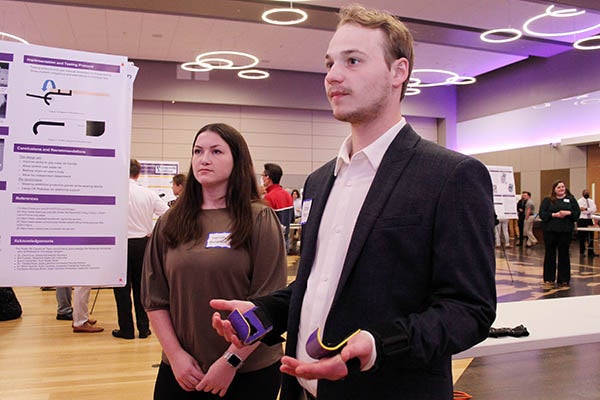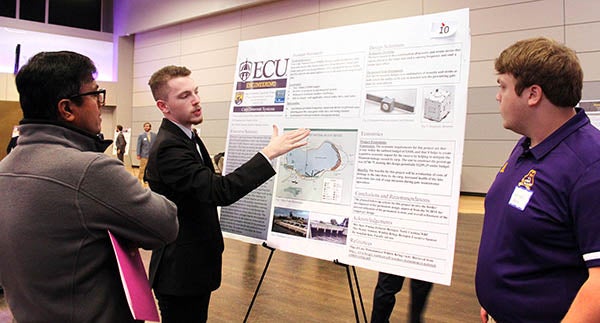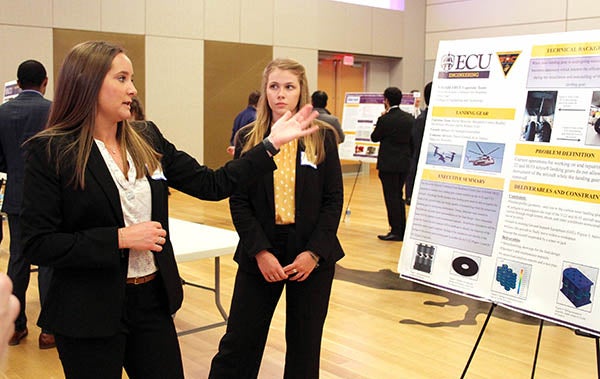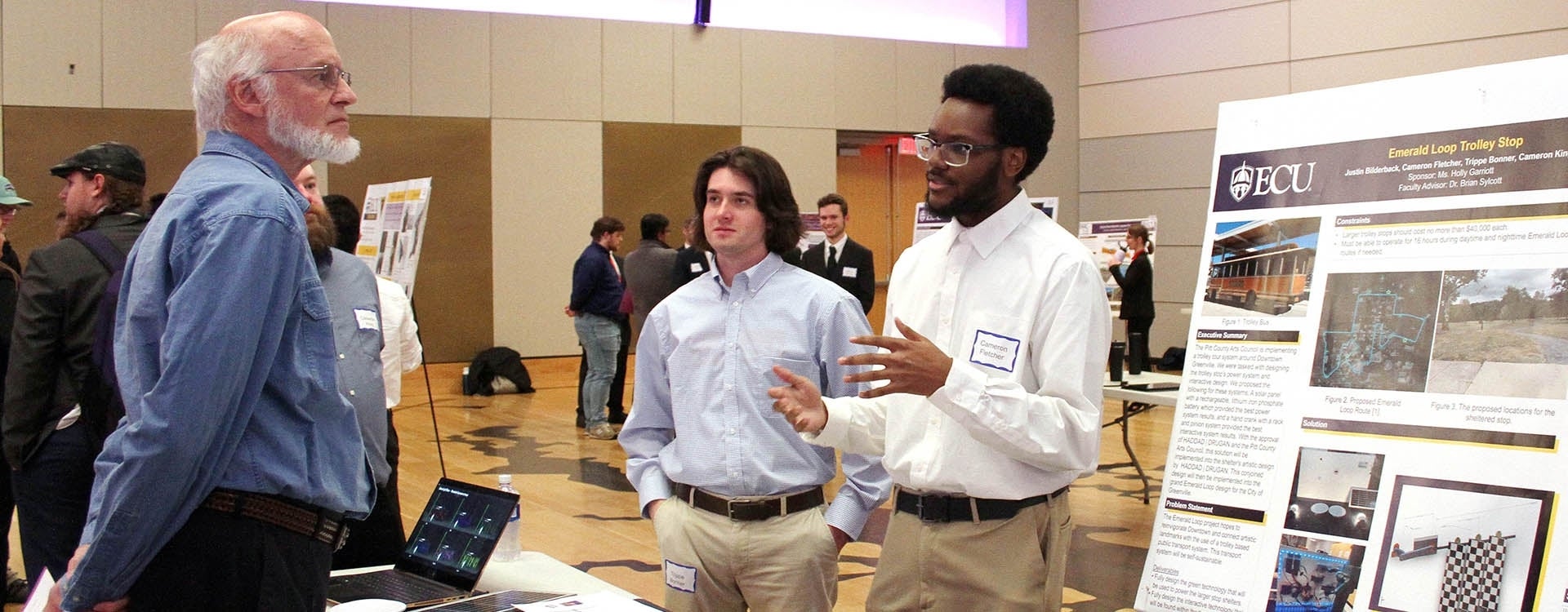ENGINEERING CAPSTONES
ECU students display senior projects at symposium
More than two dozen teams of engineering students at East Carolina University showcased their senior capstone projects during a symposium on Monday night at the Main Campus Student Center.
Projects varied in scope, but all provided the students real-world experience, whether it was working to help those with disabilities, support historical research, fix multimillion-dollar military aircraft or affect the environment.
Adaptive Water Ski Device
Students Ethan Knorr, Muzaffer Konu, Sydney Moore and Hannah Roberson worked to develop an adaptive water ski device. Current water ski handles can be difficult to grasp for those with limited hand and finger strength, so the students created a device with a curve that attaches to the hands and arms. Normal ski handles fit into the grove of the curve, but in the event of a skier’s fall, will slide out so the skier is not pulled by the boat across the water.

Student Ethan Knorr displays an adaptive water ski device designed to help those with disabilities maintain a grip on the rope handle.
“It’s great to see it come together,” Moore said. “When we started, it was just an idea and to see a finished prototype is exciting.”
Cool water temperatures prevented testing with a skier this spring, but the results of land tests have been positive. The team set up testing protocols so the device can be tested this summer as the temperature warms.
Dr. Teresa Ryan, associate professor in the Department of Engineering, served as the faculty advisor on the project, and the team worked with Dr. David Loy, associate professor of recreation sciences in the College of Health and Human Performance, as the project sponsor.
“It was nice being able to work with Health and Human Performance and have that tie between the two colleges,” Moore said.
And the team is excited that something they helped create could provide benefits to those with disabilities who may not otherwise be able to enjoy watersports.
“We got to learn about what ECU is doing for the disabled community,” Roberson said. “We are all biomedical engineers and a lot of us have an interest in prosthetics and being able to improve the quality of life for those with disabilities. Actually being able to make an impact ourselves would be really amazing knowing something that we created was able to help a large number of people.”
Carp Deterrent
Another group of students — Travis Autry, Kenneth Blais, Hamza Bhatti and Jackson Gardner — learned more about carp than they ever imagined.

Students Jackson Gardner, center, and Kenneth Blais, right, talk about their carp deterrent system for Lake Mattamuskeet.
“I had no idea about carp,” Gardner said. “We had to do a lot, a lot of research. It took a long time to get it figured out.”
They were tasked with developing carp deterrent systems for Lake Mattamuskeet in northeastern North Carolina. The carp is an invasive species in the lake with no known predators, and the growing population of the fish could damage underwater vegetation and the ecosystem of the lake on which millions of migratory birds rely.
The team developed an acoustic and strobe device that would be placed at canal entrances to the lake that would keep carp away.
“Here’s the thing about carp: They have a very sensitive swim bladder, which makes them very, very, very sensitive to any type of acoustics, so certain frequencies and noise affects their swim bladder, disabling their ability to swim or at least encouraging them not to swim in that direction,” Gardner said. “Lights are a big deterrent as well. They’re a big visual species so strobe lights have been researched to have efficacy — along with the sound — of up to 85% on both Asian and common carp.”
The sound and lights would vary in frequency and brightness so the fish don’t get used to them.
“It should essentially create an invisible barrier to them to where they’re not going to go past that point,” Gardner said.
The team, with associate professor Dr. Sunghan Kim serving as faculty advisory, is scheduled to go to the lake on Thursday to test the device.
Dummy Landing Gear
When mechanics at Fleet Readiness Center East at Marine Corps Air Station Cherry Point have to repair landing gears on aircraft, those crafts become stationary and can’t be moved, creating problems on the hangar floor.

Students Rachel Beavans and Karlyn Voltz discuss their capstone project.
Rachel Beavans, Benjamin Cortez, Bradley McDonald, Michael Quinn and Karlyn Voltz were challenged with developing a dummy nose landing gear that would fit both H-53 helicopters and V-22 Ospreys.
“It’s a universal base with adapters that will fit the H-53 and V-22,” Beavans said. “The idea behind that is in the future they’ll be able to keep our universal base and make their own adapters for various other types of aircraft.”
The system had to not only support the load of the aircraft in a stationary position, but also while the aircraft is being moved.
The pandemic made the work even more complicated because the students visited the site just one time, instead relying on aircraft manuals and virtual meetings to work on the device.
“Learning is a lot easier in person than via Zoom,” Voltz said. “It would have been better had we been able to go more than one time. Our outlook completely changed because we got to really see the differences in height in the two aircraft.”
Teaching assistant professor Dr. Suranga Gunerathne served as the faculty advisor on the project, which included stress/load analysis of the device and a future testing plan.
Supporting History
The Mariners’ Museum and Park in Newport News, Virginia, contains artifacts of the USS Monitor, a Union Civil War ironclad warship that sank during a storm off the Outer Banks of North Carolina in 1862.

Students and faculty discuss a device designed to improve the efficiency with which rust and corrosion can be removed from historical artifacts.
The ship’s artifacts that have been pulled from the sea are corroded and covered in rust. The removal of that rust involves a cumbersome process that includes the placement of the artifact in an electrolytic solution and the use of an electric current to remove the rust. However, often the level of the electric current needed is anyone’s guess.
ECU students Jason McMorris, Zach Pakulniewicz, Tyler Rowland and Matt Wilkins worked with the museum and faculty advisor Brent Reed on a more efficient potentiostat, the device that controls the electric current.
“Right now, they are changing the voltage with a knob, and they have to stay there and monitor it for such a long time,” McMorris said. “What we’re doing is automating it so it will automatically change the current to what they want it to be, so they won’t have to work the knob anymore.”
Rowland said he came into the project with an open mind.
“I didn’t know what a potentiostat was and how it is used to restore artifacts and basically restore a piece of our history,” he said. “It’s pretty exciting to be a part of making something to speed up that process and make that process a little easier.”
He also enjoyed going to the museum to see the artifacts from the Monitor, including a gun turret that is being treated in a 90,000-gallon tank.
“Getting to go up there and see the Monitor was a blast,” he said. “There were a couple of headaches here and there, but it was interesting and definitely a learning experience.”
